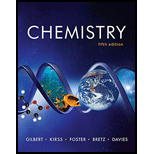
Concept explainers
Interpretation: The concentration of cobalt ion complex on dissolving the given moles of
Concept introduction: The complex ion formation constant is given by the formula,
To determine: The concentration of cobalt ion complex in the aqueous solution of ammonia and ethylenediamine.
Answer to Problem 16.71QP
Solution:
The concentration of cobalt ion complex in the aqueous solution of ammonia and ethylenediamine is
Explanation of Solution
Given
The number of moles of
The number of moles of ethylenediamine is
The number of moles of ammonia is
The total volume of the solution is
The molar concentration is calculated by the formula,
Substitute the value of number of moles of
Substitute the value of number of moles of
Substitute the value of number of moles of ethylenediamine and the volume of the solution in equation (1).
Cobalt nitrate on dissolving in the aqueous solution of ethylenediamine forma a complex ion with ethylenediamine as,
The complex ion formation constant,
The concentration of formation of
The ICE table for the formation of
The complex ion formation constant is given by the formula,
Substitute the value of
The value of
Therefore, the above equation becomes,
Therefore, the concentration of
Cobalt nitrate on dissolving in the aqueous solution of ammonia forma a complex ion with ammonia as,
The complex ion formation constant,
The concentration of formation of
The ICE table for the formation of
The complex ion formation constant is given by the formula,
Substitute the value of
The value of
Therefore, the above equation becomes,
Therefore, the concentration of
The total amount of cobalt ion complex is present as both
Therefore, the concentration of
Conclusion:
The concentration of in
Want to see more full solutions like this?
Chapter 16 Solutions
Chemistry: The Science in Context (Fifth Edition)
- At 90ºC the vapor pressure of ortho-xylene is 20 kPa and that of meta-xylene is 18 kPa. What is the composition of the vapor in equilibrium with a mixture in which the mole fraction of o-xylene is 0.60?arrow_forwardDraw the products of this reduction of a ketone with sodium borohydride. Use a dash or wedge bond to indicate the stereochemistry of substituents on asymmetric centers, where applicableIgnore any inorganic byproducts. 1) NaBH4 2) HCI/H2O Select to Drawarrow_forwardWhy do you think people who live at high altitudes are advised to add salt to water when boiling food like pasta? What mole fraction of NaCl is needed to raise the boiling point of H2O by 3˚C? Does the amount of salt added to water (typically about one teaspoon to four quarts of water) substantially change the boiling point? (Kb (H2O) = 0.51˚C/molal.)arrow_forward
- pls help asaparrow_forwardpls help asaparrow_forward9. Consider the following galvanic cell: Fe (s) | Fe(NO3)2 (aq) || Sn(NO3)2 (aq) | Sn (s) a. Write an equation for the half reactions occurring at the anode and cathode. b. Calculate the standard cell potential Show all of your work. c. Draw and label the galvanic cell, including the anode and cathode, direction of electron flow, and direction of ion migration.arrow_forward
- pls help asaparrow_forward11. Use the equation below to answer the following questions: 2 Al(s) + 3 Cd(NO3)2 (aq) → 2 Al(NO3)3 (aq) + 3 Cd(s) a. What is the net ionic equation for the reaction? b. Which species is a spectator ion in this reaction? Define a spectator ion. c. Identify the oxidizing agent and the reducing agent.arrow_forwardpls help asaparrow_forward
 ChemistryChemistryISBN:9781305957404Author:Steven S. Zumdahl, Susan A. Zumdahl, Donald J. DeCostePublisher:Cengage Learning
ChemistryChemistryISBN:9781305957404Author:Steven S. Zumdahl, Susan A. Zumdahl, Donald J. DeCostePublisher:Cengage Learning ChemistryChemistryISBN:9781259911156Author:Raymond Chang Dr., Jason Overby ProfessorPublisher:McGraw-Hill Education
ChemistryChemistryISBN:9781259911156Author:Raymond Chang Dr., Jason Overby ProfessorPublisher:McGraw-Hill Education Principles of Instrumental AnalysisChemistryISBN:9781305577213Author:Douglas A. Skoog, F. James Holler, Stanley R. CrouchPublisher:Cengage Learning
Principles of Instrumental AnalysisChemistryISBN:9781305577213Author:Douglas A. Skoog, F. James Holler, Stanley R. CrouchPublisher:Cengage Learning Organic ChemistryChemistryISBN:9780078021558Author:Janice Gorzynski Smith Dr.Publisher:McGraw-Hill Education
Organic ChemistryChemistryISBN:9780078021558Author:Janice Gorzynski Smith Dr.Publisher:McGraw-Hill Education Chemistry: Principles and ReactionsChemistryISBN:9781305079373Author:William L. Masterton, Cecile N. HurleyPublisher:Cengage Learning
Chemistry: Principles and ReactionsChemistryISBN:9781305079373Author:William L. Masterton, Cecile N. HurleyPublisher:Cengage Learning Elementary Principles of Chemical Processes, Bind...ChemistryISBN:9781118431221Author:Richard M. Felder, Ronald W. Rousseau, Lisa G. BullardPublisher:WILEY
Elementary Principles of Chemical Processes, Bind...ChemistryISBN:9781118431221Author:Richard M. Felder, Ronald W. Rousseau, Lisa G. BullardPublisher:WILEY





